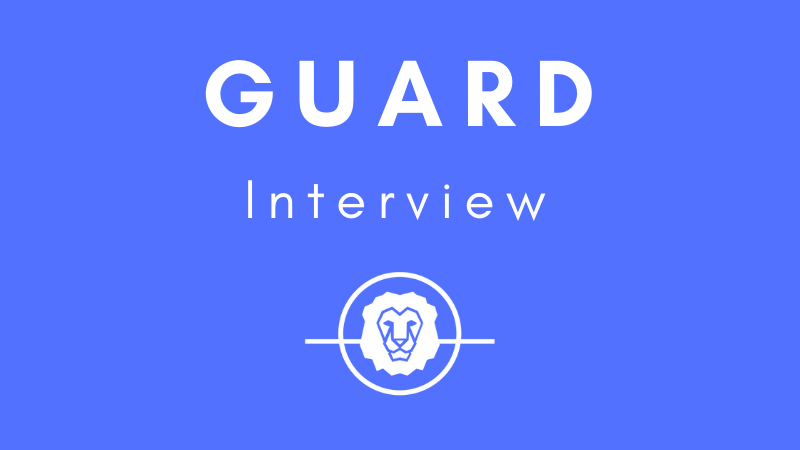
Guardian Circle aims to create a decentralized emergency response service through its mobile app and API network. The Guardian Circle application was first launched in March 2016 and allows users to invite friends, family and neighbors to be “Guardians.” In the event of an emergency, the user sends an immediate alert notification to his/her Guardians. The Guardians then enter an ‘Alert Room’ featuring location sharing and a chat feature which enables users to formulate a plan to send help.
Two years later in March 2018, Guardian Circle announced it would be moving to the NEO platform to integrate the GUARD token into its existing solution. The introduction of the token allows Guardian Circle to extend its functionality to include a marketplace for personal protection and 911 style services, as well as reward friends and family for responding to alerts.
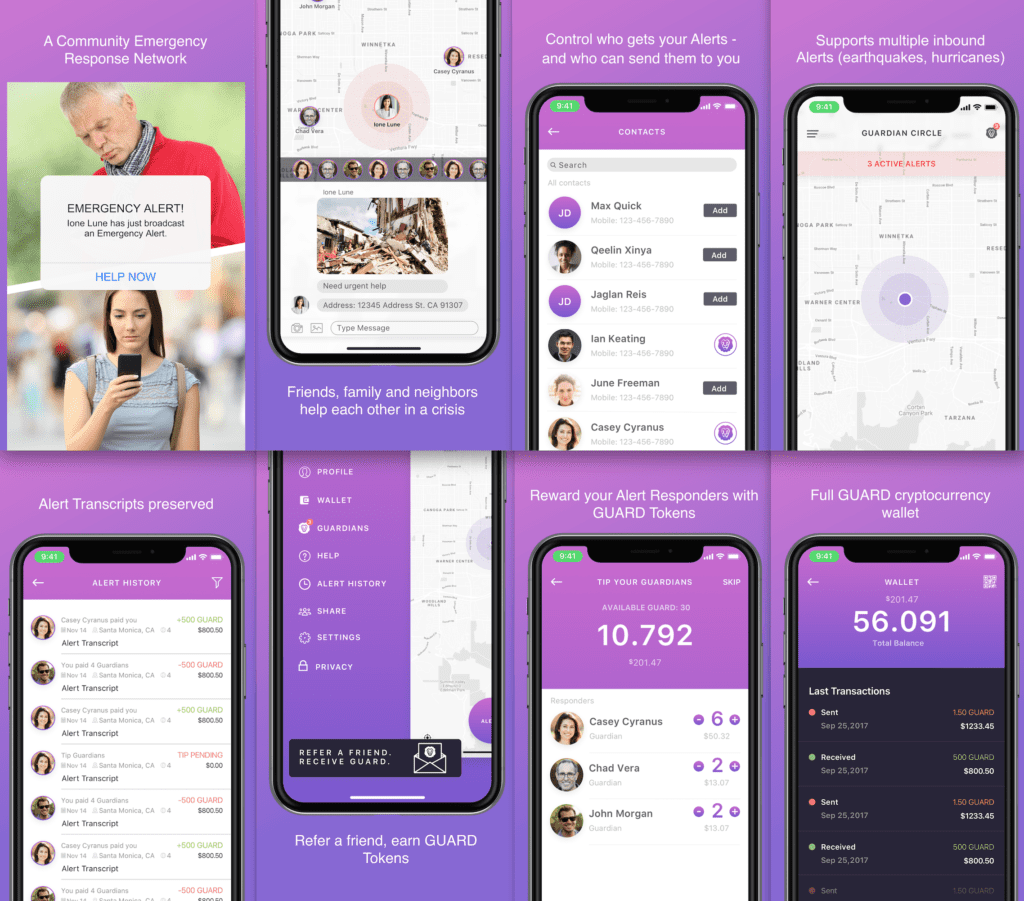
A larger goal for Guardian Circle is that it hopes to use this new economic framework to bring first responder services to 4,000,000,000 people that it claims have no access to formal emergency response services. Guardian Circle notes in its white paper that in Africa, for instance, the largest employer on the continent is private security – a luxury that is not available to the poor.
The integration of blockchain technology also allows Guardian Circle to secure Alert Room transcripts in a tamper-proof manner and create an “Emergency Info Lockbox” that contains sensitive information that is released to responders on the declaration of an alert. This information could include personal health issues or the location of a hidden front door key.
Guardian Circle completed its GUARD token sale on June 1st, 2018 raising US$3,500,000 and has spent the last seven months integrating NEO technology into its application, which will culminate in the release of Guardian Circle 3.0 in February 2019.
Founders Mark Jeffrey and Chris Hayes bring a wealth of business and marketing experience to their project. Mark Jeffrey is a veteran entrepreneur with five exits, a published author, and named one of ’50 to Watch’ by Variety. Chris Hayes founded the podcast platform ShoutEngine, and his podcast, “The Smoking Tire”, is a car industry staple whose associated YouTube channel has amassed nearly 900,000 subscribers.
The pair recently spoke with Colin Closser of NEO News Today about their GUARD token and mobile app, API infrastructure, citizen interventions, blockchain technology, and the NEO project.
Colin – NNT: So I’m a medical doctor by training, and you’re a decentralized 911 service. But blockchain is still emerging technology, and NEO’s uptime isn’t 100 percent at this point. How do you separate out the aspects that need to have 100 percent uptime from the aspects that need to be on blockchain in your app?
Chris Hayes – Guardian Circle: So, blockchain is basically used for payment mechanisms, we also use it for our information locker, and for storage of critical information from alert responses. We keep all of the response data and basically keep it on the blockchain as our cold storage mechanism. So that we have an immutable record of everything that occurred during an emergency.
Then we have what you could call an emergency information locker, where we take information that you would share only in the event of an emergency, and you can pick who has access to that data. And that is stored in encrypted format on the blockchain. And at the time that data needs to be unlocked for third parties, it shares a private key so that they can read that data off the blockchain.
Colin: So that you can tell first responders that you have a latex allergy, but you don’t have to tell the whole world, right?
Chris: Right. And you could basically dictate sharing that key via the application and say, “Let public responders and doctors have access to this,” or even theoretically, you could have a bracelet or something with a QR code with the encryption key that would give you the same thing. You wouldn’t have to share it preemptively, you could just have it as like the world’s greatest Medic Alert bracelet.
Colin: I understand the origin story of GUARD, where one of you came home and your significant other was on the floor. So, how do you deal with people that may be locked out of their phone during a medical episode?
Mark Jeffrey – Guardian Circle: So, basically we have an API that allows any alert device manufacturer to plug their alert device into our emergency grid. So anything can act as the alert generator. We’ve already plugged in Amazon Alexa so that you can yell to your Alexa – we’ve got that running now.
We worked with the Women’s Safety XPRIZE, which was basically a panic button device contest, like things you can wear around your neck, or a ring with a button on it. We had over a hundred contestants, and they plugged their prototype devices into Guardian Circle. We went out to India about six months ago and tested those devices on the streets of Mumbai with the Indian phone services. And it all worked, it worked great.
Chris: That was alpha hardware, it was working perfectly.
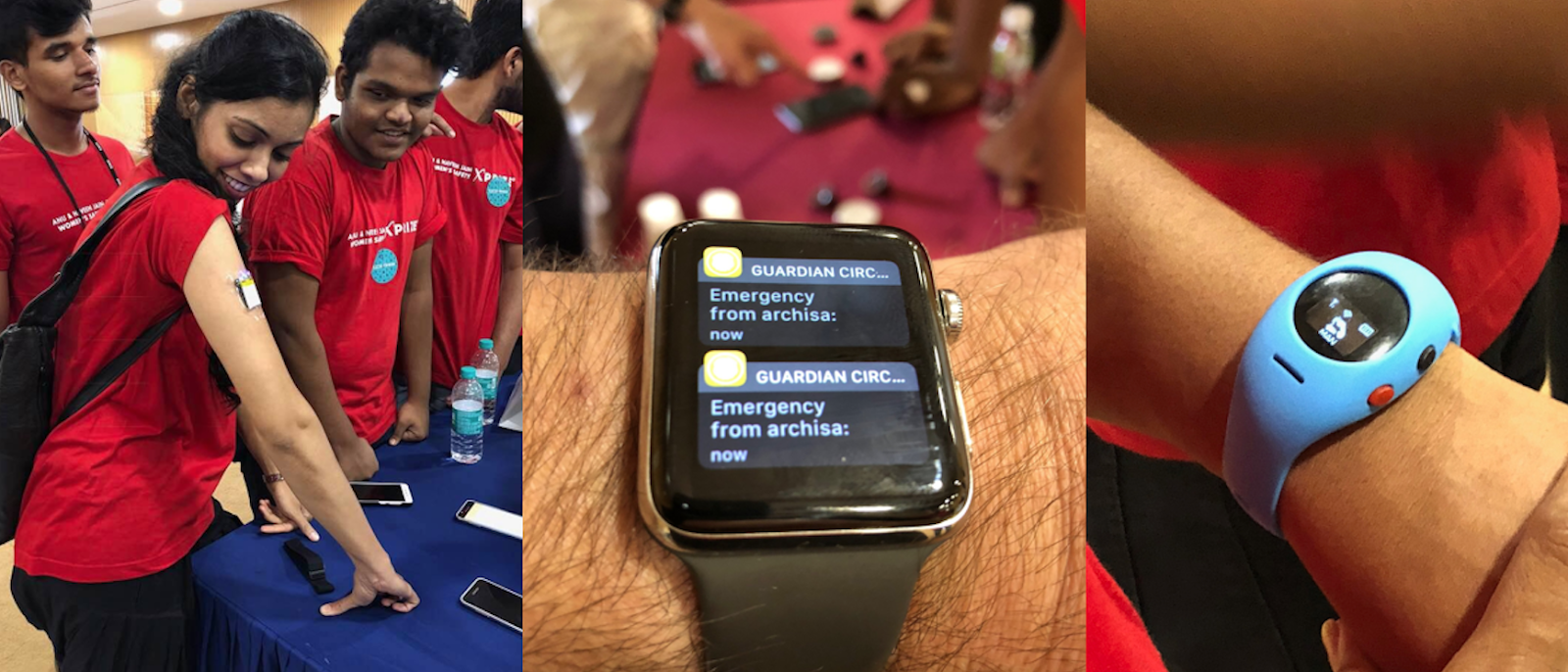
XPRIZE Devices using Guardian Circle’s API in India
Mark: We know that apps and phones aren’t necessarily the perfect alert device. So we opened up the API. Imagine things like wander detection, irregular heartbeat detection, fall detection, crash detection, a million things could be the button.
Colin: Yeah, you could have geofencing for people that have Alzheimer’s and wander at night.
Chris: Right. Or, the other things we are looking at include vehicle telematics systems where we could identify rapid deceleration. One of the issues with home alarm systems is with false alarms you get billed with the police. Well, think of a distributed alarm system that piggybacks on this network. So now home alarms become dirt-cheap and ubiquitous.
Colin: Do you have any idea what in the real world people are paying for a community response service like this?
Chris: Well actually with Guardian Circle, there is no set fee for the base community response. Basic community response using the mobile application can be done 100 percent for free. Whereas you can basically stake GUARD in our system and you can get people who would be more inclined with special skill sets to do that kind of response. We don’t have fixed prices on that stuff, it will be set by the market.
Colin: You’re hoping for free you can push a button and probably get someone to check on alive status?
Mark: What we’re hoping to do now is create community responders – friends, family, and neighbors – who would come anyway. And by sprinkling GUARD out to them when they download Guardian Circle, and providing an easy way for them to tip each other when one of them hits a button and a bunch of them come, then eventually our hope is GUARD becomes more valued in these communities. It starts off being worth very little, but over time, as people start equating that token with safety, it becomes worth more and more. And down the road, people will start staking GUARD, and say when I hit the button and there is 1,000 GUARD up for grabs – That’s a really high reward perhaps at some point in the future. And so I command a footprint on the emergency grid that’s larger than other people’s. So GUARD equals safety, eventually.
That’s a mercenary view of the way our system works. But we also have a heart, so referring people into the system, you can earn GUARD. There’s going to be a philanthropy system in the future where you can designate a cause, like women’s safety in India. And you can track every donated dollar as easily as a FedEx package.
Going back to the API for a second. One of the uses of the GUARD token, and pricing may change, but right now, if you stake one GUARD, you have the right to add one device to the alert grid, forever, until you un-stake, then the device is disconnected from our API. In practice, we won’t do that immediately, but you get the idea. So, it’s unlike most API models where it’s a per-month licensing fee. We will offer that too, but in the future. When you stake for API access now, you’re invested in helping us build the ecosystem.
Colin: What are you focusing on right now from a development perspective?
Mark: I think right now our heads are down on the 3.0 version of the GUARD application. The big improvements are, we have the GUARD wallet built right into the app so you won’t have to use an external NEO wallet. And also when an alert ends we create a tip screen of everyone that responded to that alert, you won’t have to go individually track everyone. You can decide who gets what amount of GUARD. And with one button, off it goes to everybody. So we’re streamlining all that.
It’s still primitive but this is the first time blending all of this stuff together. Down the road, we want to make everything more sophisticated.
Chris: Also, the new client that comes out, it’s natively written, the previous versions were using an abstraction layer. This is our third incarnation of the app, where the blockchain stuff really starts getting integrated. We pre-dated all the ICO buzz.
Colin: Who are your ideal users right now or maybe down the line? Because it seems like existing first responders would be ideal, but even church members have value, right?
Mark: Oh, absolutely, yes. There’s so many areas even in our world where people don’t have emergency response or it’s low quality. If you’re in a remote area – even near me, on a bike path, in Los Angeles – there’s areas where it’s difficult for offical services to get to.
Chris: Or during a hurricane, where there are no emergency services. Someone with a medical issue at home might have someone down the street that’s a former miltary medic or something like that, and can go alleviate the situation.
Mark: We’re also looking at partnering with services such as intrusion detection, a face that’s not recognizable is inside the house, and it knows nobody else is home. So it can set off the alert.
Chris: The key thing about Guardian Circle is we have our consumer-facing apps, but our bigger product play in my opinion is this API infrastructure, where it is general-purpose alerting and response. So it can be tied into a security system, or a fire alarm, it can be tied into a car. We’re just providing one of the reference applications for that, and it comes with a wallet that’s structured for the average user. That said, GUARD is an NEP-5 token, so our tokens can be sent from other wallets as well. An advanced user could live outside of our mobile app.
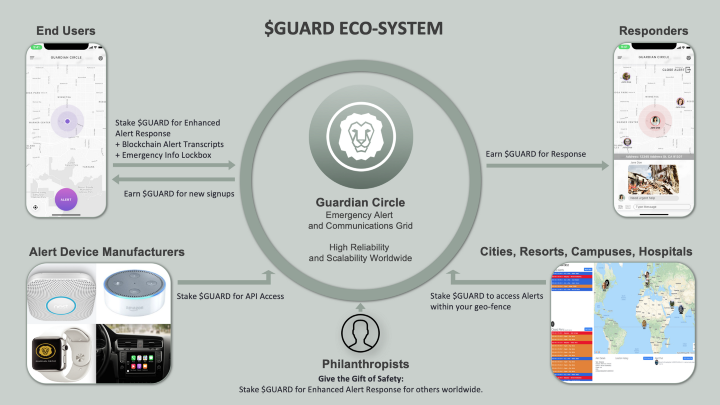
Colin: So you’re in California, I’ve heard there’s a lot of lawyers out there. I know that as a doctor, Good Samaritan laws protect me if someone collapses on the sidewalk and I come to their aid, but accidentally harm them. You’re kind of deputizing people to respond to some possibly volatile situations through your app. Do you know what kind of legal framework is in place that governs those interactions? Let’s say someone is breaking into your house.
Mark: Don’t think of our responders as Batman or armchair EMTs. Think of them as friends, family, and neighbors, who are attending to your emergency. But ‘attending’ doesn’t mean that they themselves solve it. They could come over, they see you’re on the floor passed out, they call 911, and they tell 911 where you are. That, alone, is insanely valuable. When the medics arrive, that person is in contact via Guardian Circle with a lot of people, one of which is your mom. Your mom knows you’re allergic to bee stings. Now the neighbor who’s at your side can tell the EMT: You’re allergic to bee stings. So now the EMT’s not starting from scratch.
As a doctor, you know. You find somebody passed out, you’re like, I don’t know what it is; could be a lot of different things. Guardian can narrow your search to be a lot smaller by telling you certain things.
If you’re under assault, It depends on where you are in the world, but most people should not become Batman. Though, a lot of times, just someone showing up, scares away the bad person. Bad people like to operate in shadows. The second there’s a witness of any kind, they run.
There’s a lot of good that can be done without having to incur Good Samaritan laws.
Colin: I heard you were considering moving off NEO and saw some attractive features of other blockchains. But there were some details about how the NEO code calls contracts that makes it a good match for your GUARD app?
Chris: One of the biggest things when working with the NEO blockchain is that, with the nodes fully exposed through the REST API they can be called very easily. That is one of the biggest benefits to it. Whereas, a lot of blockchains you end up having to cook your own wallets or use third party libraries in order to actually integrate with the blockchain. Because of the way that the NEO guys, very smartly, integrated a REST API around the command-line node, it allows us to do that without having to reinvent the wheel. Everybody we know working on things in the EOS universe are having to use a third-party library, or they are having to implement their own codebase, just to talk to the blockchain. Which is one really nice thing about working with NEO, is that just for basic wallet functionality, we don’t have to worry about recreating all that stuff. And the things specifically around setting allowances on wallets is very, very handy for us implementing contracts in regards to payment for goods and services.
Mark: Every time you create a new EOS account, you have to pay in EOS. And depending on the price of EOS, it’s between $1 and $10. Per new user. Now, we shot a television show. We were featured in Alex Winter’s full-length documentary, Trust Machine, about blockchain and the technology’s global impact. We are up for consideration for Newsweek’s Blockchain Impact Awards, and we have version 3.0 of the app launching in February. If somehow we suddenly get a million users, then it costs us somewhere between $1 and $10 million dollars.
Colin: Let alone if you get a massive onboarding during a bull run.
Mark: Right, just that alone is death. Secondarily, Chris and I have spoken about the need to Trojan Horse the crypto aspect of Guardian Circle for novices, so they don’t have to know it’s crypto. It can intimidate certain audiences. Chris can do that very easily in NEO. In EOS, we have a friend who made an EOS wallet. It took him three months, 10 guys, all working sixty-hour weeks, just to deliver that wallet. That’s because a lot of the developer-friendly primitives that exist in NEO don’t exist in EOS. They had to write their own signing algorithms.
Colin: If NEO does, if NGD does what it says it will, you don’t need your own chain, you just need a highly liquid, transferable token, and everything will work perfectly. You supply the app, NEO supplies the blockchain, and hopefully transaction fees are close to zero so the economics work out. And then you can onboard users?
Chris: To be clear, even if the NEO ecosystem didn’t change at all, and nodes were stable, we have everything we need to operate with our current feature set. There’s no ‘what if.’ It does what we need it to do, already.
Which is one of the things that we nailed home when we were talking to the EOS people. Like, “Look, this is working now, this isn’t a promise of ‘maybe’ some time in the future”. This is doing what we need it to do already. And that’s why we are on NEO.
Mark Jeffrey and Chris Hayes are co-founders of Guardian Circle. Mark is scheduled to speak on day two of the 2019 NEO DevCon in Seattle.





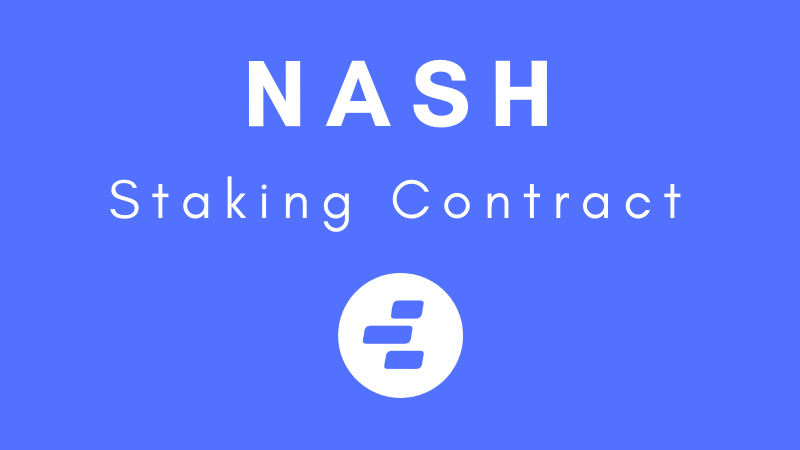
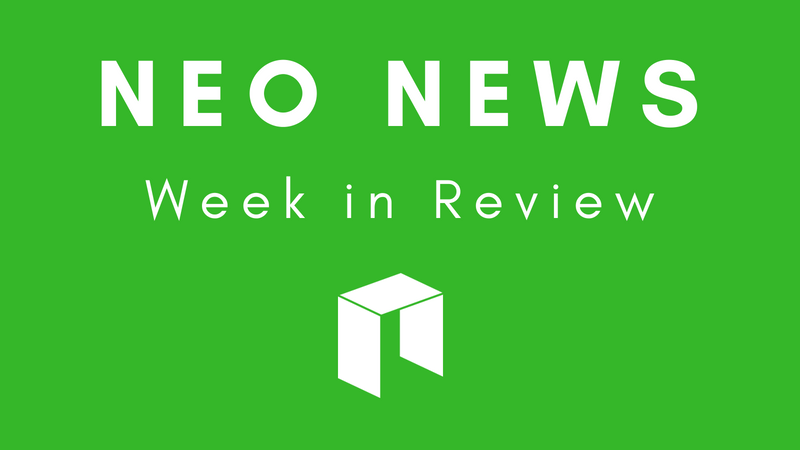
About The Author: Colin Closser
Colin Closser, M.D., was a speaker at the first NEO DevCon in San Francisco. A devoted contrarian, he has managed the improbable: a peaceful and healthy life, despite holding a medical degree. He aspires towards the wisdom of Michael Lewis and Nassim Nicholas Taleb.
More posts by Colin Closser